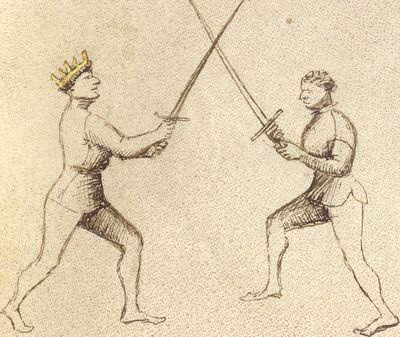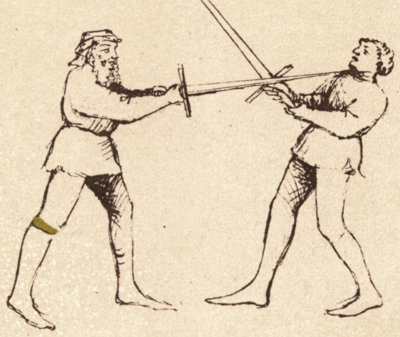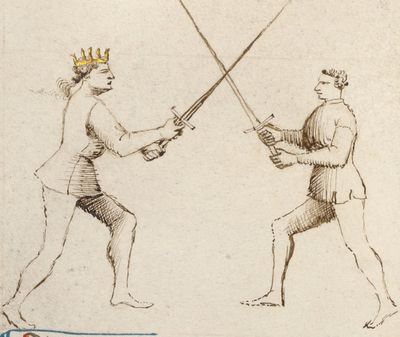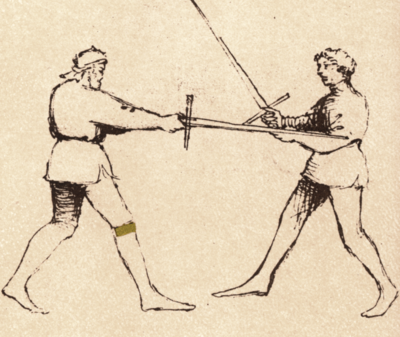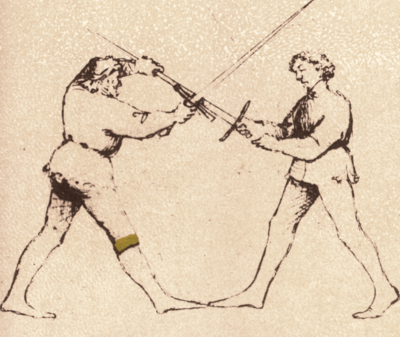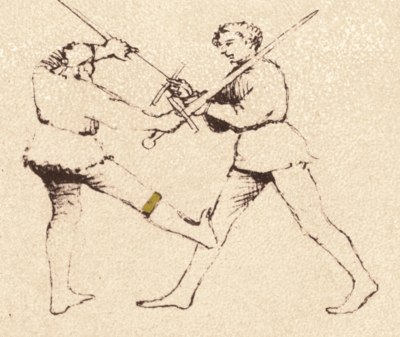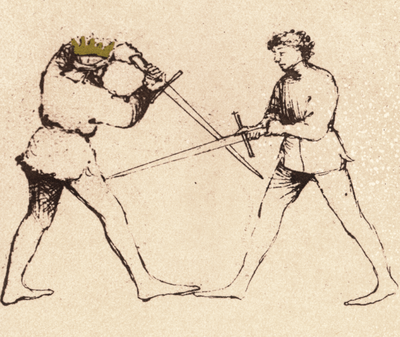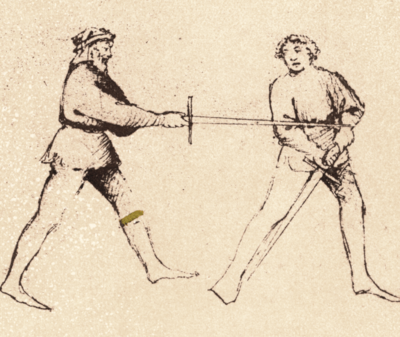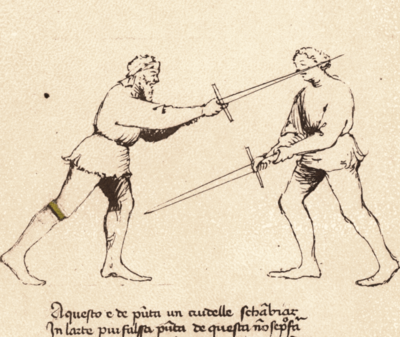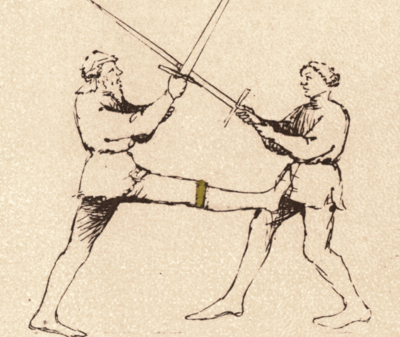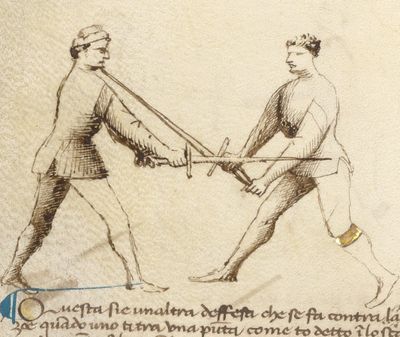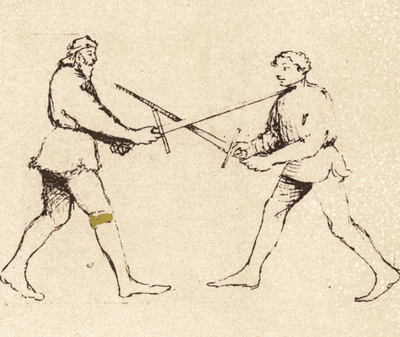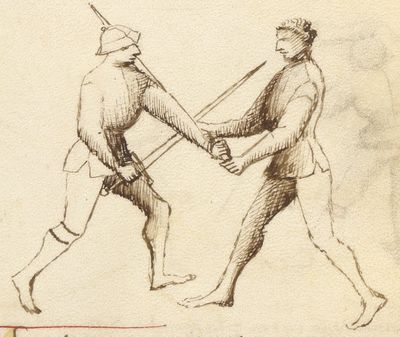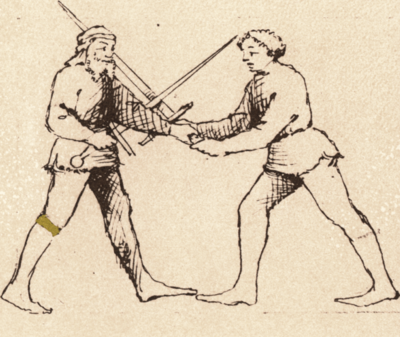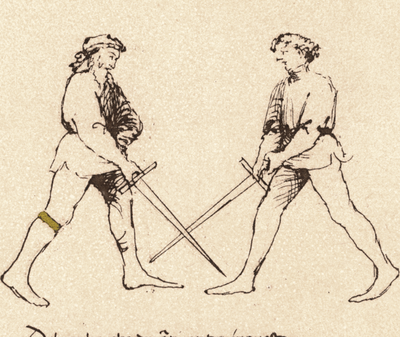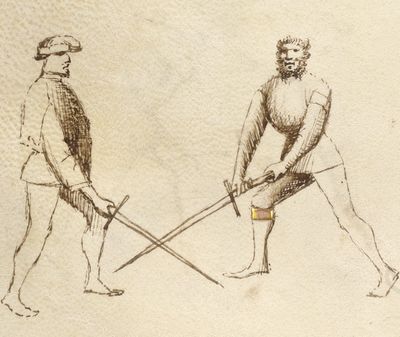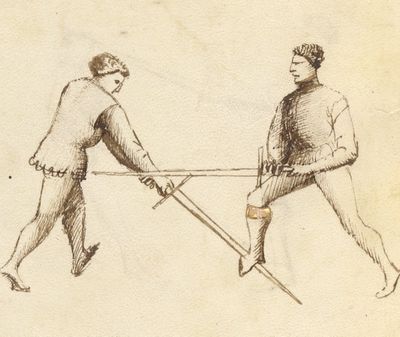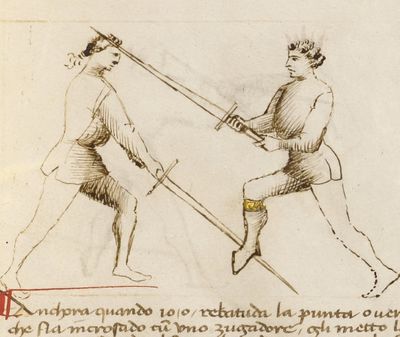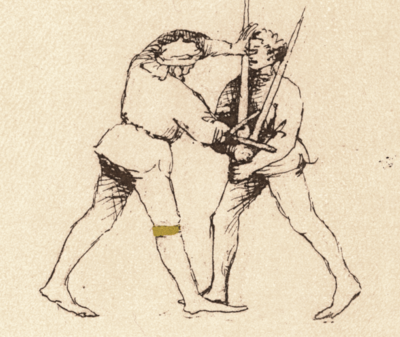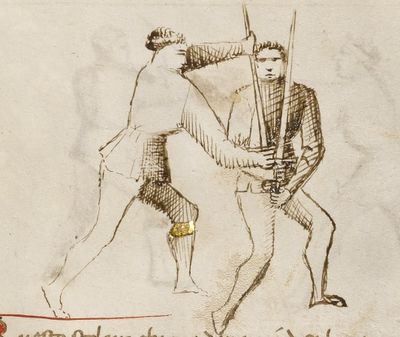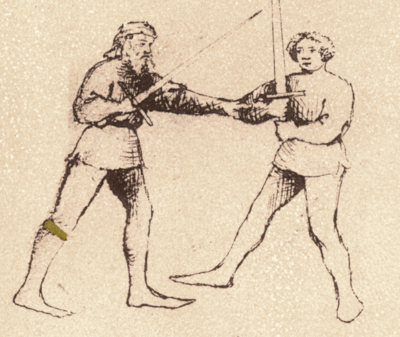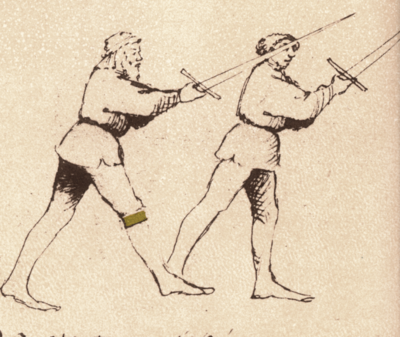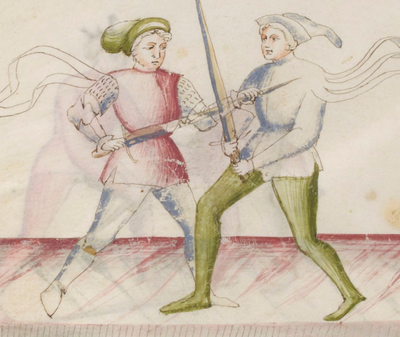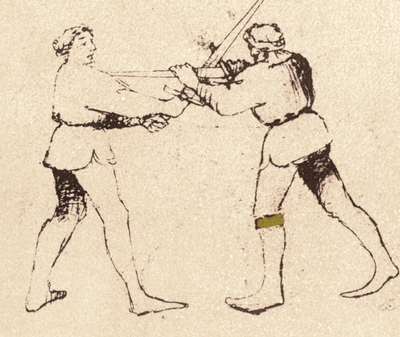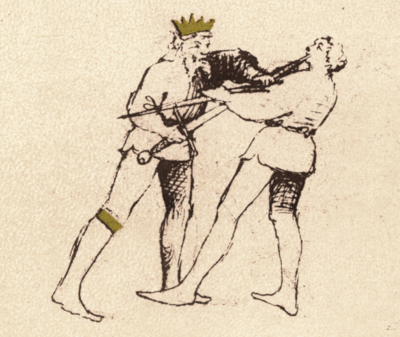|
|
You are not currently logged in. Are you accessing the unsecure (http) portal? Click here to switch to the secure portal. |
Fiore de'i Liberi/Sword in Two Hands/Wide Play
Illustrations |
Illustrations |
Novati Translation |
Paris Translation |
Morgan Transcription (1400s) |
Getty Transcription (1400s) |
Pisani Dossi Transcription (1409) |
Paris Transcription (1420s) |
|---|---|---|---|---|---|---|---|
| [No Image] | [26] I am the sword, deadly against all weapons. Neither spear, nor poleaxe, nor dagger can prevail against me. I can be used at long range or close range, or I can be held in the half sword grip and move to the Narrow Game. I can be used to take away the opponent’s sword, or move to grapple. My skill lies in breaking and binding. I am also skilled in covering and striking, with which I seek always to finish the fight. I will crush anyone who opposes me.[1] I am of royal blood. I dispense justice, advance the cause of good and destroy evil. To those who learn my crossings I will grant great fame and renown in the art of armed fighting. |
[25r-t] ¶ Spada son contro ogni arma mortale, ne Lanza ne Azza ni daga contra mi vale. Longa e curta me posso fare. e me strengho e vegno alo zogho stretto, e'vegno allo tor de spada e allo abrazare mia arte si'e roture e ligadure so ben fare de coverte e ferire sempre in quelle voglio finire, chi contra me fara, ben lo faro languire. E son Reale e'mantegno la Justicia, la bonta acresco e destruzo la malicia. Chi me guardera fazendo in me crose, de fatto de armizare gli faro fama e vose. |
|||||
[27] By crossing with you at the tip of the sword Here begins the Wide Play of the sword in two hands.[2] This Master who is crossed at the point of his sword with this player says: “When I am crossed at the points, I quickly switch my sword to the other side, and strike him from that side with a downward blow to his head or his arms. Alternately, I can place a thrust into his face, as the next picture will show.” [In the Pisani Dossi, the player is wearing a crown.] |
I hold the sword constricted in the cross[ing] with the point. Here begins the wide play of the sword in two hands with a little crossing; the honor will be to whoever will know to make it. This Master who is here crossed with this player says "When I am crossed at the tip of the sword, I quickly give a turn to my sword and thus I strike with a downward blow from the other side (that is, through the head and through the arms), or I thrust the point into his face as you see hereafter in my depiction." [In the Paris, both Masters have their right feet forward. In the Morgan, the player is wearing a garter and crown.] |
[13v] Aqui comenza zogo largo de spada a doe mane cum pocho incrosare, lo honore sera de chi meio savera fare. [13v-a] Questo magistro ch'e aqui incrosado cum questo çugadore dise quando io sono incrosado in punta de spada subito io do volta ala mia spada, e si lo fiero del'altra parte cum lo fendente zoe per la testa, e per gli brazi, overo o ch'io gli metto una punta in lo volto. Como vuii vederite qui de dredo da mi dipento. |
[25r-c] ¶ Qui cominza zogho di spada a doii man zogho largo. Questo magistro ch'e qui incrosado cum questo zugadore in punta de spada, dise quando io son incrosado in punta de spada, subito io do volta ala mia spada e si lo fiero dal'altra parte cum lo fendente zo per la testa e per gli brazzi, overo che gli metto una punta in lo volto, come vederi qui dredo depinto. |
[19b-a] Per incrosar cum ti a punta de spada |
[14r-a] ¶ In cruce compressam teneo cum cuspide spatam. ☜ | ||
[28] With the strike of which the Master spoke who came before, I have placed a thrust into his face, as the previous Master said. Also, I could have done what he told you, that is, when my sword was crossed on the right I could have quickly switched sides to the left, striking his head or arms with a downward blow.”[3] |
Now hear my discussion of the earlier master: I have set my point in his face as said my Master who came before. Also, I could have made the [other] play that he said—that is, to have attacked with my sword immediately when I was beside the crossing of the right side: from the other side (that is, from the left) I should have immediately turned my sword into a downward blow to the head and to the arms, as has said my Master that came before. |
[13v-b] Io te ho posto una punta in lo volto, como lo mio magistro ch'e denanci dise. Anchora poria avere fato zo ch'ello dise, zoe avere trato de mia spada, subito quando io era apresso lo incrosare della parte dritta dell'altra parte zoe della stancha io debeva voltare subito la mia spada in lo fendente per in la testa e per gli brazi como ha ditto lo magistro mio ch'e denanci. |
[25r-d] ¶ Io t'o posta una punta in lo volto come lo magistro ch'e denanci dise. Anchora poria aver fatto zo ch'ello dise zoe aver tratto de mia spada subito quando io era apresso lo incrosare dela parte dritta. del'altra parte zoe dela stancha io debeva voltare la mia spada in lo fendente per la testa e per gli brazzi, como a ditto lo mio magistro ch'e denançi. |
[19b-b] Per lo ferir che dise el magistro ch'e denançi posto |
[14r-c] ¶ Audito sermone mei nunc ante magistri | ||
[29] By crossing at mid-sword, I will strike your left arm; I too am crossed in the Wide Play, but this time at the middle of the swords. And immediately after making my cross I let my sword drop down[4] to slide forwards and backwards over his hands. Or, if I choose to pass forward with my right foot and move offline, I can then make a thrust into your chest, as you will see drawn next. [In the Pisani Dossi, the player is wearing a crown.] |
I, the clever one, holding the sword now in the middle, with the sword Again I am crossed here for the long play, at mid-sword. And immediately when I am crossed, I allow my sword to run off over his hands, and if I want to step out of the way with my right foot, I can thrust my point into his chest as is depicted hereafter. [In the Morgan, the player is wearing a garter and crown.] |
[13v-c] Anchora me incroso qui per zogo largo, a meza spada. E subito quando io sono incrosado io lasso discorere la mia spada sopra le suie mane, e se voglo passare cum lo pe dritto fora de strada io gli posso mettere una punta in lo petto come vui vedite qui dredo dipento. |
[25v-a] ¶ Anchora me incroso qui per zogho largo a meza spada. E subito che son incrosado, io lasso discorrer la mia spada sopra le soi mane, e se voglio passare cum lo pe dritto fuora de strada, io gli posso metter una punta in lo petto, come qui dredo e depento. |
[19b-c] Per incrosar a'meça spada el braço stancho te feriro |
[14v-a] ¶ In medio nunc ense tenens ego callidus ensem | ||
[30] From the Master who crosses at mid-sword, Here you see me completing the play of my teacher. I have made his cover, and then immediately I do what he said to do, that is I strike first to my opponent’s arms, and then I continue with a thrust into his chest. |
I strike a bargain with you just as that earlier master before said. The play of my Master I have completed, in that I have made his cover and I have quickly executed his saying: I have struck first his arms, and then I have placed my point in his chest. |
[13v-d] Lo zogho delo mio magistro io l'o compido, che i'o fatto la sua coverta. E subito, o fatto el suo ditto. Che i'o feridi prima gli brazi, e poii gle ho posta la punta in lo petto. |
[25v-b] ¶ Lo zogho del mio magistro io l'o complido, che io o fatta la sua coverta, e subito o fatto lo suo ditto, che io o'ferido prima gli brazzi, e poii gl'o posta la punta in petto. |
[19b-d] Per lo magistro che incrosa a'meça spada |
|||
[31] Also from this same crossing My master previously[8] instructed me that when I am crossed at mid-swords with my opponent, I should immediately advance forward and seize his sword as shown, and then strike him with a cut or a thrust.[9] Also I could destroy his leg as you see drawn next, by stomping with my foot against the side of his knee or under the kneecap.[10] |
My Master who came before has taught me that when I am crossed at the mid-sword, I should immediately advance forward and grab his sword (as in this match) in order to strike him with edge or point. Also, I can waste his leg in the way that you will be able to see depicted hereafter by striking with my foot over the back of his leg or under his knee. |
[14r-a] Ello mio magistro che m'e denanci m'a insegnato che[11] quando a meza spada io son cum uno incrosado che subito me debia acresere in denanci e piglare la sua spada a questo partito, per ferirlo taglo, o punta. Anchora gle posso guastare la gamba per lo modo che voi possete vedere aqui dipento a ferirlo cum pe sopra la schena della gamba, overo sotto lo zinochio. |
[25v-c] ¶ El mio magistro ch'e denanzi m'a insegnado che quando a meza spada io son cum uno incrosado che subito mi debia acresser inanci, e piglar la sua spada a questo partido per ferirlo taglo o punta. Anchora gli posso guastar la gamba per lo modo che possi vedere qui depento a ferirlo cum lo pe sopra la schena dela gamba overo sotto lo zinochio. |
[20a-a] Anchora per quello proprio incrosare |
|||
[32] There is no question of the saying of the earlier Master, As the previous student told you, our Master taught us this technique.[12] Here I show you how it’s done, and as you can see my opponent can do nothing to stop me. |
The Scholar who came before me says of his Master and mine that he has taught this play, and I do it to crumple [my opponent]. Without a doubt, to do it is little trouble to me. |
[14r-b] Lo scolar che m'e denanzi dise del suo magistro, e mio che llo gle ha insignado questo zogo, e per vezuda io lo fazo. A farlo senza dubio ello m'e pocho impazo. |
[25v-d] ¶ Lo scholaro che m'e denanzi dise del suo magistro e mio ch'ello gli ha insegnado questo zogho, e per vizuda io lo fazo. A farlo senza dubio, ello m'e pocho impazo. |
[20a-b] Lo dito del magistro denançi de quello non ne questione |
|||
[33] I have uncovered you well by stepping out of the way This play is named “The Peasant’s Strike”[13] and you do it like this: take a narrow stance[14] with your left foot forward, and wait for the Peasant to attack first with his sword. When he launches his attack, immediately advance your left foot to the left off the line,[15] and step diagonally off line to the left with your right foot, receiving his strike in the middle of your sword. Now let his sword slide off yours to the ground, and then quickly counter-attack with a downward strike to his head or arms, or a thrust into his chest as you see drawn in the next picture. This is also a good play if you are fighting sword versus poleaxe, or against a heavy or light staff. [In the Getty, the Master is missing his crown.] |
This play is called the Villain's Strike, and is made in this way: that is, that one should await the villain in this way until he strikes with his sword. And he who awaits the blow should stand in a small stance with the left foot forward. And in that moment when the villain attacks to harm you, advance your left foot out of the way against the right side.[16] And with your right foot step out of the way to the side, catching his blow at the mid-sword and allowing his sword to run off toward the ground, and then quickly respond with a downward blow (through the head or through the arms) or with your point in the chest as depicted here, this is also good. [In the Morgan, the Master is missing his crown.] |
[14r-c] Questo zogo e chiamado lo colpo del vilano, e si fa per tal modo. Zoe che si de aspetare lo vilano ch'ello traga cum sua spada. E quello che aspeta lo colpo di stare in picolo passo cum lo pe stancho denanci. E in quello che lo vilano te tra per ferirte. Acrese lo pe stancho fora de strada inverso la parte dritta. E cum lo dritto pe passa ala traversa fora de strada, piglando lo suo colpo a meza spada e lassa discorere la sua spada a terra, e subito respondigli cum lo fendente per la testa overo per gli brazi overo cum la punta in lo petto come qui dipento. ancora questo e bono. |
[26r-a] ¶ Questo zogho si'e chiamado colpo di villano e sta in tal modo, Zoe che si de aspettare lo villano che lo traga cum sua spada. E quello che lo colpo aspetta de stare in picolo passo cum lo pe stancho denanzi. E subito che lo villano ti tra per ferire, acresse lo pe stancho fora de strada inverso la parte dritta, E cum lo dritto passa ala traversa fora de strada pigliando lo suo colpo a meza la tua spada. E lassa discorrer la sua spada a terra, e subito responde gli cum lo fendente per la testa overo per gli brazi, overo cum la punta in lo petto come depinto. Anchora e questo zogho bon cum la spada contra la Azza, e contra un bastone grave o liziero. |
[20a-c] Per passar fora de'strada io t'o ben discoverto |
|||
[34] The strike to your arms, that play I make, In the previous drawing you saw the Peasant’s Strike, in which you saw a thrust well-placed into the attacker’s chest. And alternatively he could have struck a downward blow to the opponent’s head or the arms, as I explained previously. Also, if the opponent seeks to counter me by striking back up with a rising blow to my arms from the left, I quickly advance my left foot and place my sword over his, and from this position he can do nothing to me. |
This is the Villain's Strike which appeared here before me, so that I have put my point into his chest well. And so I could [also] have made a cut through the head and through the arms with a downward blow as was said before. Also, if the player wanted to come against me such that he would strike me with a backhand blow under my arms, I would immediately advance my left foot and thrust my sword over his, and then he cannot do anything to me. |
[14r-d] Questo e lo colpo del vilano ch'e qui denanci de mi. Che bene gle ho posta la punta in lo petto. E cosi gle posseva fare uno colpo per la testa, e per gli brazi cum lo fendente como e ditto denanci. Ancora s'eio[!] volesse lo zugadore contra de mi fare che ello volesse ferirme cum lo riverso sotto gli mie brazi. Io subito acrescho lo pe stancho e meto la mia spada sopra la sua, e non mi po far niente. |
[26r-b] ¶ Qui denanci si'e lo colpo del villano, che ben gl'o posta la punta in lo petto. E cossi gli posseva un colpo per la testa fare e'per gli brazzi cum lo fendente comme ditto denanzi. Anchora se'l zogadore volesse contra de mi fare volendo mi ferire cum lo riverso sotto gli miei braççi, io subito acresso lo pe stancho, e metto la mia spada sopra la sua. e non mi po far niente. |
[20a-d] Lo ferire deli braçi aquello zogho te faço |
|||
[35] When a sword flies for your leg If your opponent strikes to your leg, withdraw your front foot, or pass backwards and strike downwards to his head, as shown in the drawing. With a two handed sword it is unwise to strike to the knee or below, because it is too dangerous for the one striking. If you attack your opponent’s leg, you leave yourself completely uncovered. Now, if you have fallen to the ground, then it is all right to strike at your opponent’s legs, but otherwise it is not a good idea, as you should generally oppose his sword with your sword. |
When one strikes for your leg, withdraw the foot which is forward or return it behind, and throw a downward blow to his head as depicted here. Note that the sword in two hands should not attack from the knee down, because the danger to he that attacks is too great. He that attacks for the leg remains wholly uncovered, unless he would drop to the ground—then he could strike the leg well, but otherwise [he could] not when fighting sword to sword. |
[14v-a] Quando uno te tra per la gamba, discrese lo pe ch'e denanci. O tu lo torna indredo e tra dello fendent per la sua testa. Come aqui dipento. Ben che cum spada a doe mane non se de trare dello genochio in zu, perche e tropo grande pericolo aquello che tra. Che lo romane tuto discoverto quello che tra per la gamba. Salvo che se uno fosse cazuto in terra, ben se poria trar per gamba. Ma altramente non stando spada contra spada. |
[26r-c] ¶ Quando uno te tra per la gamba, discresse lo pe ch'e denanzi. O tu lo torna in dredo. e tira del fendente per sua testa come qui depento. Ben che cum spada de doii man non si de trare del zinochio in zu. Pero ch'e troppo grande pericolo a choluii che tra. Ch'ello rimane tutto discoverto quello che tra per gamba. Salvo che se uno fosse cazudo in terra poria si ben trar per gamba. Ma altra mente no, siando spada contra spada. |
[20b-a] Quando la spada per la gamba si volla |
|||
[36] When I am crossed with someone and come to the narrow, This play, where I strike you with a kick to the groin, is made to hurt you so much that your cover will falter. When you make this play you should do it quickly, to prevent your opponent from being able to counter it. The counter to this play must be done quickly, and is made by the player grabbing the student’s right leg with his left hand, and then throwing him to the ground. |
In this match I strike you with my foot in your testicles, and I do it to give you pain and to make your cover waver. Thus, in making this play I want to do it suddenly so that the counter is doubtful. The counter of this play wants to be made quickly, such that the player should catch the Scholar by the right leg with his left hand, and then he can throw him to the ground. |
[14v-b] Aquesto partito che io te fiero cum lo pe in gli coglura el fazo per farte doia, e per farte svariarte la coverta che fazando questo zogo vole essere fato subito, per non aver dello contrario dubito. Lo contrario de questo zogo vole essere presto fatto zoe che lo zugadore de piglare per la gamba dritta lo scolaro, cum sua mane stancha e in terra lo po butare. |
[26r-d] ¶ Questo partido che io ti fiero cum lo pe in li cogloni el fazo per far te doglia e per far te svariare la coverta. Che fazando questo zogho vol esser fatto subito, per non avere del contrario dubito. Lo contrario di questo zogo vol esser presto fatto, zoe che lo zugador de piglare per la gamba dritta lo scolaro cum sua mano stancha, e in terra lo po buttare. |
[20b-b] Quando io me incroso cum uno e'vegno al'streto |
|||
[37] This is a cruel exchange of thrusts: This play is named “The Exchange of Points”,[17] and it is done like this: when your opponent thrusts at you, quickly advance your front foot off the line, and with the other foot step to the side,[18] also moving off the line, crossing his sword with your hands[19] low and with your point high into his face, or chest, as you see drawn here. |
If, suddenly, we turn our sword by means of the play, This play, which is called the Exchange of Thrusts, is made in this way: that is, that when he attacks with the point, quickly advance your forward foot out of the way and with your other foot step to the side (also out of the way), crossing his sword with your arms low and with the point of your sword up in his face or in his chest, as is depicted here. |
[14v-c] Questo zogo che se chiama scambiare de punta, e se fa per tal modo zoe quando te tra una punta subito acrese lo tuo pe denanci fora de strada a cum l'altro pe passa ala traversa anchora fora de strada, atraversando la sua spada cum gli toii brazi bassi, E cum la punta dela spada erta in lo volto o in lo petto come e aqui dipento. |
[26v-a] ¶ Questo zogho si chiama scambiar de punta e se fa per tal modo zoe. Quando uno te tra una punta. subito acresse lo tuo pe ch'e denançi fora de strada, e cum l'altro pe passa ala traversa anchora fora di strada, traversando la sua spada cum cum[20] gli toi brazzi bassi, e cum la punta dela tua spada erta in lo volto o in lo petto come depento. |
[20b-c] Aquesto e de punta un crudelle schambiar |
[15r-a] ¶ Si subito nostrum ludendo vertimus ensem / | ||
[38] Because of your hilt, which I hold in my hand, This play comes from the exchange of points that came before me. If you make the thrust, and your opponent fails to immediately position his point either into your face or into your chest, perhaps because you are in armor, then you should quickly pass forward with your left foot, and seize his sword as shown here. Then strike him hard with your sword, since you have his sword gripped and he cannot escape. |
Although you hold me with hands, anything is overthrown. I would From this exchange of thrusts that came before me comes this play. Given that the Scholar who came before me did not immediately thrust his point into the face of the player, or that he failed such that he could not thrust into [the player's] face nor into his chest, or that the player was armored, then immediately the Scholar should step with his left foot forward, and he should grab [the player] in this manner, and his sword should throw a good strike because the player has his sword caught and he cannot flee. |
[14v-d] De questo scambiar de punta che m'e denanci essi aquesto zogo. Che subito lo che lo scolar che m'e denanci non metesse la punta in lo volto delo zugadore ch'ello la falasse ch'ello non la metesse in lo volto ne in lo petto, o perche fosse lo zugadore armato. Subito debia lo scolar cum lo pe stancho innanci passar. E per questo modo lo debia piglare, e la sua spada metero[!] a bon ferire, po che lo zugadore e presa sua[22] spada non po fuzir. |
[26v-b] ¶ De questo scambiar de punta che m'e denanzi, essi questo zogho, che subito che lo scolar che m'e denanzi non metesse la punta in lo volto del zugadore, e'lassasela si'che non la metesse ne in lo volto ne in lo petto, e per che fosse lo zugador armado, Subito debia lo scolaro cum lo pe stancho inanci passare, e per questo modo lo debia piglare. E la sua spada metter a bon ferire poii che lo zugador a presa sua spada e non po fuzire. |
[20b-d] Per tuo mantigner che io in mia man tegno |
[15r-c] ¶ Quamvis me teneas manibus / quid proderitur. Hac te | ||
[39] Here we stand crossed near the ground: This is another defense you can make against the thrust. When someone thrusts at you as described in the “Exchange of Thrusts”,[23] two plays before me, then you must advance and step off the line. You should do the same thing in this play, except that in the “Exchange of Points” you thrust back with your hands low and your point high, as I explained earlier. But in this play, which is named “Breaking the Thrust”,[24] you proceed with your hands high and as you advances and step off the line you strike downwards, crossing the opponent’s thrust at mid-sword, and driving it to the ground. Then you quickly close to grapple.[25] |
We remain in the form of the cross now in this playing. [The Paris resembles the Pisani Dossi image.] |
[26v-c] ¶ Questa si'e un'altra deffesa che se fa contra la punta zoe quando uno ti tra una punta come t'o detto in lo scambiar de punta in lo segondo zogo che m'e denanzi che se de acresser e passar fora di strada. Chossi si die far in questo zogho, salvo che lo scambiar de punta se va cum punta e cum gli brazzi bassi e cum la punta erta dela spada come detto denanzi. Ma questo se chiama romper de punta che lo scolaro va cum gli brazzi erti e pigla lo fendente cum lo acresser e passare fora de strada e tra per traverso la punta quasi a meza spada a rebater la a terra. E subito vene ale strette. |
[21a-b] Aqui stasemo noii a terra incrosadi |
[15v-a] ¶ In forma crucis hic nos nunc luctando manemus. | |||
[40] I beat your point to the ground very quickly The student who preceded me beat his opponent’s sword to the ground. Now I am going to complete his play, as follows: after I beat my opponent’s sword to the ground I stomp on it with my right foot.[26] This will either break it or prevent him from being able to lift it. But wait—there’s more. As soon as I have pinned his sword to the ground with my foot, I strike him with the false edge of my sword under his beard or into his neck. And then immediately I will return with a downward strike of my sword to his arms or his hands, as you see drawn here. [In the Pisani Dossi, the Scholar stomps with his left foot and his opponent's right foot is forward; the Scholar's opponent is also left-handed.] |
Now your wicked hand would suddenly drag the point through the |
[26v-d] ¶ Lo scolaro che m'e denanzi a rebatuda la spada del zugador a terra. & io complisco lo suo zogho per questo modo. Che rebattuda la sua spada a terra, io gli metto cum forza lo mio pe dritto sopra la sua spada. Overo che io la rompo, o la piglo per modo che piu non la pora curare. E questo non me basta, che subito quando gl'o posto lo pe sopra la spada, Io lo fiero cum lo falso dela mia spada sotto la barba in lo collo. E subito torno cum lo fendente dela mia spada per gli brazzi o per le man come depento |
[21a-a] Rebati tua punta in terra ben subito |
[15v-d] ¶ Nunc tua per terram subito manus impia puntam | |||
[41] From the crossing at the ground which the Scholar makes Here is another drawing of the “Breaking the Thrust” play, that you saw first two drawings previously. After I have beaten his sword to the ground I quickly pin it to the ground with my right foot, and then strike him in the head, as you see shown here. [In the Pisani Dossi, the Scholar stomps with his left foot and his opponent's right foot is forward.] |
So, of course, quickly I would tear open your face by means of this action. |
[27r-a] ¶ Anchora questo zogho del romper di punta ch'e lo segondo zogho che m'e denanzi. Ch'e quando io o rebattuda la spada a terra, subito io fiero cum lo pe dritto sopra la sua spada. E in quello ferire io lo fiero in la testa come voii vedete. |
[21a-c] Per lo incrosar de terra che fa lo scolar |
||||
[42] From the play that came before, I enter into this one: This is another play that flows from the “Breaking of the Thrust” play. After I break his thrust, if he raises his sword to cover as I strike upwards, I quickly drop the hilt of my sword inside his right arm, near his right hand, then I grab my blade near the point with my left hand, and then strike him in his face.[28] Or alternatively, if I chose, I could drive my sword edge into his neck, slicing him across his throat. |
[27r-b] ¶ Questo e anchora un altro zogho del romper de punta, che si lo zugadore in lo rompere ch'i'o rotta la sua punta, leva la sua spada ala coverta dela mia subito io gli metto l'elzo dela mia spada dentro parte del suo brazo dritto apresso la sua mane dritta, E subito piglo la mia spada cum la mia man mancha a presso la punta, e fiero lo zugadore in la testa. E se io volesse, metteria la al collo suo per segargli la canna dela gola. |
[21a-d] Del çogho ch'e denançi entro inquesto |
|||||
[43] I will make you turn by pinching your elbow Also, after I have beaten aside or crossed my opponent’s sword, I can press my left hand to his right elbow and push strongly. This will turn him and leave him unprotected, after which I can strike him. |
[27r-c] ¶ Anchora quando io, o, rebatuda la la punta o vero che sia incrosado cum uno zugadore, gli metto la mia mane dredo al suo cubito dritto, e penzolo forte per modo che io lo façzo voltare e discovrire, e poii lo fiero in quello voltare, che io gli faço fare. |
[21b-a] Per pinçer lo tuo cubito io te'faro voltar |
|||||
[44] Because of the turn that I have given you by the elbow The student who preceded me spoke truly when he told you that he could turn the opponent and cut to his head. In addition, before you could turn back to make cover I would give you a major wound in your back with the point of my sword. |
[27r-d] ¶ Questo scolaro che m'e denanzi dise lo vero che per la volta ch'ello ti fa fare per questo modo dredo de ti la testa ti vegno a taglare. Anchora inanzi che tu tornassi ala coverta, Io ti poria fare in la schena cum la punta una piaga averta. |
[21b-b] Per la volta che t'o dada per lo cubito |
|||||
[45] I appear to come from the right, but I enter on the left This play is named “The False Point” or “The Short Point”,[29] and I will explain how to do it. I make it look like I am making a powerful attack against my opponent with a crosswise strike to his head. As he makes cover I strike his sword but only lightly. Then I quickly turn my sword to the other side of his blade, gripping my sword with my left hand at about mid-sword. From there I can quickly make a thrust into his throat or chest. This play is however better in armor than without armor. [The Getty resembles the Pisani Dossi image.] |
I steal in on [you] in the sly part from the honest part;[30] |
[27v-a] ¶ Questo zogo si chiama punta falsa e punta curta, e si diro come la fazzo. Io mostro de venire cum granda forza per ferir lo zugadore cum colpo mezano in la testa. E subito ch'ello fa la coverta, io fiero la sua spada lizera mente. E subito volto la spada mia del'altra parte piglando la mia spada cum la mane mia mancha quasi al mezo. E la punta gli metto subita in la gola o in lo petto. Ed'e miglore questo zogo in arme che senza. |
[21b-c] Mostraii de'vegner dal drito in lo riversso intraii |
[28v-c] ¶ Obliquam in partem recta d(e?) parte subivj. | |||
[46] To the Deceitful Thrust that you wanted to strike at me, This play is the counter to the previous play, the False Point or the Short Point. And this counter is made like as follows: when the student strikes my sword lightly and then turns his sword around to the other side, I turn my sword around his in exactly the same way, stepping sideways to the left as I do so to gain his unprotected side. From here I can make a thrust into his face. And this counter is good both with or without armor. |
[27v-b] ¶ Questo si'e lo contrario del zogho che m'e denançi, zoe de punta falsa overo di punta curta. E questo contrario si fa per tal modo. Quando lo scolaro fieri in la mia spada, in la volta ch'ello da ala sua spada Subito io do volta ala mia per quello modo che lui da volta ala sua. Salvo che io passo a la traversa per trovar lo compagno piu discoverto. E si gli metto la punta in lo volto. E questo contrario e bono in arme e senza. |
[21b-d] Per punta falssa che tu me volisti ferir |
|||||
| [No Image] | [47] Here ends the Wide Play of the sword in two hands, made up of plays that are all connected to each other, including remedies and counters from both the right and left sides, and counter-thrusts and counter-cuts to each situation, with breaks, covers, strikes and locks, all things that can be easily understood. |
[27v-c] ¶ Qui finisse zogho largo dela spada a doii mani, che sono zoghi uniti gli quali ano zoghi, zoe rimedii e'contrarii da parte dritta, e de parte riversa. e contra punte e contra tagli de zaschuna rasone cum roture coverte, ferire e ligadure, che tutte queste chose liçerissima mente se pono intendere. |
- ↑ The word Fiore uses is “languire” to make someone collapse, without either strength or spirit.
- ↑ “Spada a doy man” means “two handed sword” or “sword in two hands”. I prefer the latter however, because Fiore’s “sword in one hand” (shown elsewhere) is not a single hand or arming sword. It is the Italian “longsword” being wielded in one hand. In both “sword in one hand” and “sword in two hands” the same sword is being used—the two handed sword. So strictly speaking here this section is “the two handed sword being used with two hands”.
- ↑ In translating this text I have left out the repetition of the expression “what the previous Master told you”, as it is redundant. Generally when I translate Fiore I try to make the text make sense to the modern reader. This may sometimes mean leaving words out, altering an expression, or altering the tense of verbs entirely.
- ↑ “discorrere” means to run backwards and forwards. This suggests a sawing motion if applied to the sword, i.e. a push forward and a pull back.
- ↑ Levum previously appeared on 13v; it is likely laevum (“left”, rather than levum, “light” in the weight sense) despite not having the ae ligature used on earlier pages in this text (an e with a narrow loop sticking off the lower left side, pointing down and left). Several of these e-for-ae substitutions have happened; maybe he has stopped using the ae symbol.
- ↑ Added later: "dixit".
- ↑ Added later: "con? ut."
- ↑ “Denanzi” or “denanci” means “in front of” when applied to position, and “previously” or “before” when applied to time.
- ↑ Fiore rarely uses the word “taglio” when talking of the sword striking as opposed to thrusting. For hitting he usually uses the word “colpo”, a “blow”.
- ↑ Fiore actually writes “against the back of his leg or under his knee” which makes no sense. The stomp depicted is effective against the inside of the knee joint from the side or just under the kneecap from the front. This is an example where my personal knowledge of the mechanics of this stomp contradicts the literal text, and where the literal text thus makes no sense.
- ↑ "m'a insegnato che" partially effaced.
- ↑ “Zogho” translates as “play” or “game” but could also translate as “technique”.
- ↑ A “Villano” is a peasant, i.e. a person not of noble birth. Fiore uses the term “Villano” to refer to a man lacking in skill. Fiore’s art, in Fiore’s own words, was not taught to commoners. The “Peasant’s Strike” is an over committed and uncontrolled downward strike, a strike that does not stop on the center line but continues to the ground. Because it is uncontrolled it lies outside Fiore’s Arte e Scientia. Thus it is attributed to a Peasant, who is unskilled in sword-fighting.
- ↑ Another example where the word “passo” does NOT mean “a passing step”. Here it translates best as “a stance” (foot position).
- ↑ Fiore actually writes that you should move your left foot off the line “inverso la parte dritta”, which translates “towards the right side”. However, you are NOT moving your left foot to your right side but to your left side. The translation “towards the right side” only makes sense if you translate it as “towards your opponent’s right side.”
- ↑ I understand "against the right side" to mean "toward the left side", but it's an odd expression.
- ↑ “Scambiar de punta” could translate as either “exchange of points” or “exchange of thrusts”. Both work here, but I favor the translation “exchange of points”.
- ↑ “Passa a la traversa” means “step crosswise”. I've used "step to the side". You will note that only a few words later Fiore uses the word “traversando” which here means “crossing” as in “crossing swords.”
- ↑ Fiore actually says “brazzi” (“arms”) low, but he means your hands.
- ↑ "cum" appears twice, but neither is struck out.
- ↑ Madentem means dripping with either sweat or tears.
- ↑ Word bisected by sword.
- ↑ There is a pun here, since this play could be called both “Exchange of Thrusts” and/or “Exchange of Points” (“punta”).
- ↑ There is a pun here too, since this play could be called both “Breaking the Thrust” and/or “Breaking the Point” (“punta”).
- ↑ “Le strette” (“La stretta”) means “close range” here.
- ↑ Fiore literally writes: “I put with strength my right foot above his sword.” I’ve translated all that simply as “I stomp on it.”
- ↑ Added later: "pro operarj".
- ↑ Fiore says strike to the head, but clearly in this play the sword blade will strike into the opponent’s face. Thus it would not be an effective move if the opponent had a steel visor protecting his face.
- ↑ Other translations translate “Punta Falsa” as “False Thrust”. However, this is not a false thrust. It is a false (pretend) strike. The final killshot is a thrust, as Fiore says “into the throat or chest”, but that thrust is not “false”, i.e. not a feint. Therefore I choose to translate it as “False Point” or “Short Point”.
- ↑ Or “I extend underneath into the oblique part from the straight part.”

